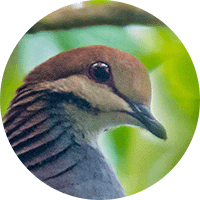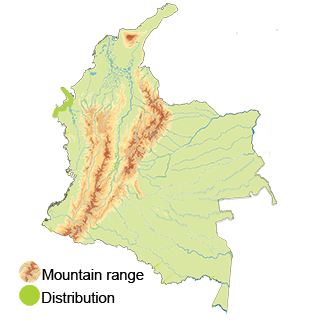Russet-crowned Quail-dove
The Russet-crowned Quail-dove (Zentrygon goldmani). Read in Spanish
Appearance: The Russet-crowned Quail-dove is a medium-sized bird with a unique appearance. It has a distinctive russet-colored crown, which contrasts with the overall plumage that varies from shades of brown to gray. The underparts of the bird are typically lighter in color, often featuring subtle patterns.
Habitat: This species is predominantly found in the cloud forests of the Colombian Andes. It inhabits areas with dense vegetation, often at higher elevations where it prefers moist, cool environments. The Russet-crowned Quail-dove is known to be a shy and elusive bird, typically staying hidden within the dense undergrowth.
Behavior: The Russet-crowned Quail-dove is primarily a ground-dwelling bird, foraging for seeds, fruits, and insects in the leaf litter. It is known for its soft, whistling calls that are often heard echoing through the cloud forests. This species is generally solitary or found in pairs, and it tends to be elusive and difficult to spot due to its secretive nature.
Breeding: Breeding habits of the Russet-crowned Quail-dove are not extensively documented. Like many other dove species, they likely form monogamous pairs during the breeding season and build nests in concealed spots on the ground or low in bushes. The female usually lays one or two eggs, and both parents are likely involved in incubation and care of the young.
Conservation Status: The Russet-crowned Quail-dove is listed as Near Threatened on the IUCN Red List.
Distribution
The Russet-crowned Quail-dove (Zentrygon goldmani) is considered to be locally common in Eastern Panama and a small extension into far northwestern Colombia. Locally is found at elevations of 750 to 1600 m
Taxonomy
The Russet-crowned Quail-dove (Zentrygon goldmani)
- Kingdom: Animalia
- Phylum: Chordata
- Class: Aves
- Order: Columbiformes
- Family: Columbidae
- Genus: Zentrygon
- Species: Zentrygon goldmani
Vocalization
The Russet-crowned Quail-dove (Zentrygon goldmani)
- Whistling Calls: The vocalizations of the Russet-crowned Quail-dove are characterized by soft, melodious whistles that are often heard echoing through the dense undergrowth of the cloud forests. The bird's call is described as a series of clear, flute-like whistles that can vary in pitch and tone. These whistling calls are used for communication within the species, likely for maintaining contact between individuals or pairs within the dense vegetation where they typically reside.
- Advertising Calls: During the breeding season, the Russet-crowned Quail-dove may vocalize more frequently, using its calls as a form of advertising for potential mates. The calls may become more pronounced and frequent as individuals establish territories and communicate their presence to other birds in the vicinity.
- Contact Calls: The Russet-crowned Quail-dove may also use contact calls to communicate with its mate or offspring while foraging or moving through the forest understory. These calls help individuals stay in contact with each other and maintain a connection, even when hidden among the dense vegetation.
- Alarm Calls: Like many bird species, the Russet-crowned Quail-dove may produce alarm calls in response to potential threats or disturbances in its environment. These alarm calls can alert other nearby birds to the presence of predators or other dangers, helping to coordinate a collective response to ensure safety.




